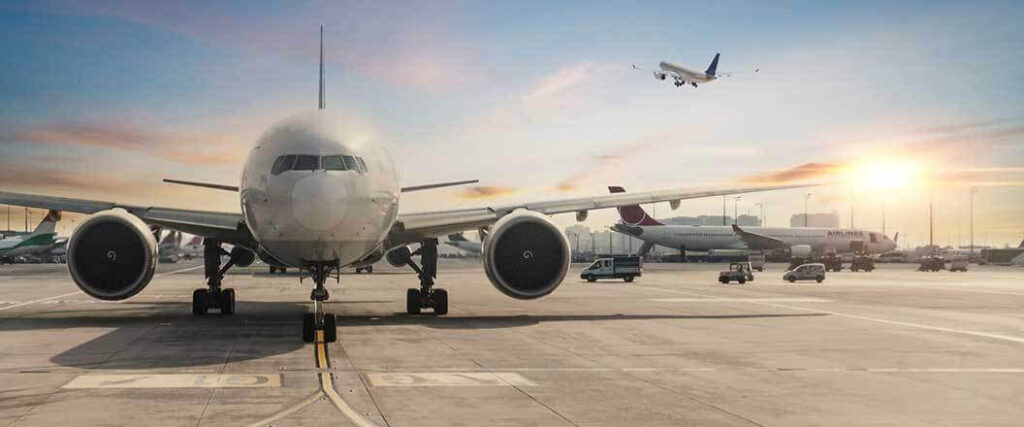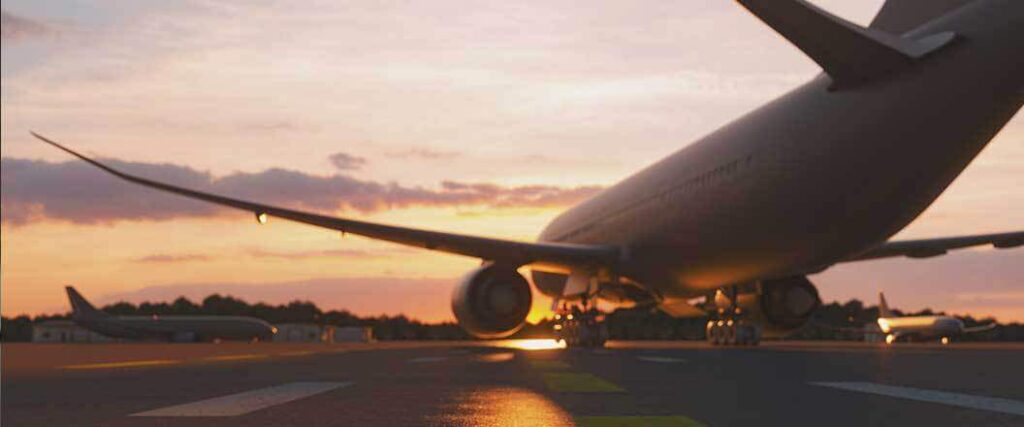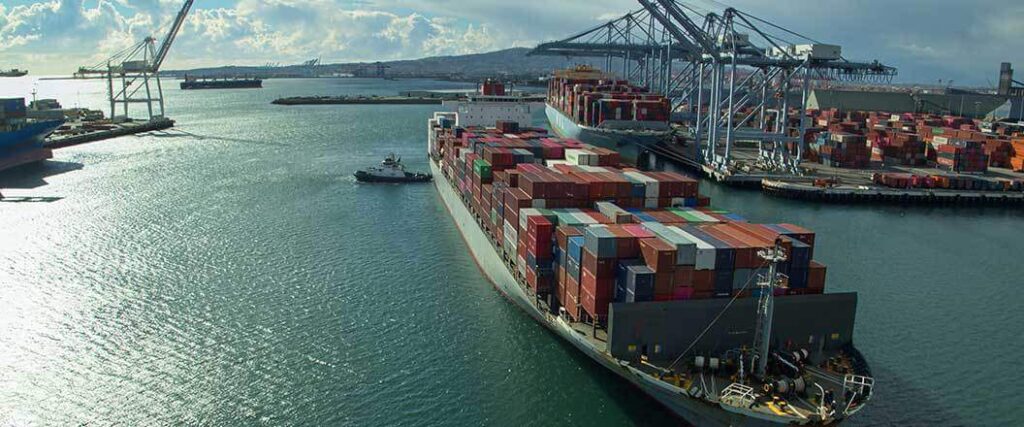Exporting aircraft parts from the United States is a profitable but very involved business. Regulations for exporting can depend on the type of parts as well as what purpose the aircraft using them is meant to serve. The Covid-19 pandemic resulted in changes in demand and top destinations leaving exporters to work in new areas.
The Department of Commerce (DOC) Bureau of Industry and Security (BIS) controls the export of aircraft, engines, and parts for civil use. Export licensing is based on the Export Administration Regulations (EAR) and most apply to parts with military and civil dual-use applications. Regulations might apply even after export.
See how the world market for U.S. aircraft parts has changed and how to successfully and safely export around the world.

The aircraft export market and the air transport industries are closely linked, to the point where one can heavily affect the other. The ratio of manufacturers to companies is significantly smaller than in other transport industries. When supply chain concerns pop up, there are fewer alternative suppliers when compared to the automotive industry for example.
Like many industries, the aviation sector experienced a sudden drop in growth even as demand for air freight services went up. While manufacturing and exporting have risen, it hasn’t been a steady or constant process.
Export success now relies on where in the U.S. you are working from. Suppliers in some states have recovered more quickly than others.
The top exporting states in the U.S. are currently:
All of these states experienced significant drops and even Washington, home to the manufacturing giant Boeing, have yet to reach their pre-pandemic export levels.
However, you shouldn’t find that discouraging. The shuffle in export capacities has allowed other states, such as Florida, which wasn’t even in the top five before the pandemic, to fill in gaps. Exporters can take advantage of suppliers in these states who are eager to fill in the gaps left by others.
The United States is actually one of the top three exporters of aircraft parts in the world. According to ExportPlanning, there was actually a $13 billion trade surplus in aircraft parts in 2019 between the U.S. and its trade partners.
Those numbers have changed since the industry took a significant hit in 2020. While the U.S. is still a top exporter, it has been slower to recover and reach pre-pandemic numbers. However, as of June 2022, aircraft parts were the fourth most exported commodity just behind a variety of petroleum products.
This is a good sign for exporters who are looking to get into international trade. A recovering industry is eager to explore new markets and respond to changing demands in technology.
Specific products made in the U.S. that are in high demand include:
The manufacture and sale of these components is expected to push the U.S. back to the number one spot by 2030.

Since the U.S. is home to some of the largest aircraft manufacturing companies in the world, the simple answer is that it exports to almost every country with a significant aviation sector. Traditionally, its biggest export markets outside North America have been Asia and Europe.
In recent years, even before the pandemic, aircraft parts exports to Europe were declining due to tariff issues with certain companies. At the same time, countries that exported limited numbers of aircraft parts, such as the United Kingdom and France, were ramping up their own manufacturing divisions.
The high demand for aircraft parts and rising dollar worth of exported products means that the U.S. has more competition than before. Exporters should study the trade data in growing markets to find the best opportunities.
For export purposes, you should consider two kinds of markets. The first includes nations that the U.S. has long-standing trade history with. The second includes countries that are experiencing rapid development and looking to import aircraft parts and even entire airplanes to support their changing conditions.
Narrowing down the trade data to only include items under HS code 8803, which includes parts of balloons, aircraft, and spacecraft parts, shows the countries that have imported the highest dollar worth of goods over the course of five years.
| Country | Total Value (USD) |
| Saudi Arabia | $3.97 billion |
| Japan | $3.86 billion |
| South Korea | $1.83 billion |
| Australia | $1.68 billion |
| Italy | $1.66 billion |
These countries might not represent the countries with the greatest worth of exported aircraft every single year, but it does indicate which nations have the most consistent numbers. When you need to run a business, consistency is worth investing in.
If you see yourself as more of a risk taker, you can look into exporting to countries with rising markets. During the pandemic, a number of countries increased their imports.
| Country | Growth Percentage |
| Australia | 111% |
| India | 116% |
| Bulgaria | 488% |
| Niger | 336% |
| Macau | 607% |
You could have the opportunity to become a major exporter to a nation that is working to expand or improve its current aircraft. If the nation is still working to develop its infrastructure, working closely with experienced cargo export services can help you avoid unnecessary hangups with the local import laws.
The Wright brothers may have credit for the first short flight in South Carolina, but modern aviation really came about after the limits of the technology were pushed into overdrive by World War I.
As wonderful and useful as the power of flight is, the U.S. takes aviation technology seriously, especially when it might have a military application. Because of this, there are some aircraft parts that require an export license to leave the country.
In addition, there are a number of individual entities, not necessarily countries, that the government has deemed illegal to sell any kind of aircraft or parts thereof to - even something as basic as a propeller.
Exports to the following groups or countries are banned:
These restrictions apply whether you are selling the complete plane or just engines and parts. Other types of flight equipment, usually items not generally used in a civilian plane, might need to go through export clearance procedures.
These include items such as:
Outside of these restrictions, aircraft parts meant for civilian use are usually exported without the need to apply for special licenses. However, even after export, and whether a license was required or not, all U.S.-made products continue to fall under EAR so continued use is tracked.
For instance, if parts are sold to a distributor in Niger, that distributor cannot sell the U.S.-origin parts to persons or nations that the U.S. has already refused to sell to.

The Department of Commerce is the agency most involved in monitoring aircraft parts exports. The DOC is a very large agency, however; so direct regulations and specifics of export laws are done through smaller bureaus working within, such as the BIS.
If the aircraft parts being exported are for military use or have dual-use applications, transactions are going to include the U.S. State Department. Like the DOC, there are smaller agencies within the organization that focus on aircraft specifically.
We’ll take a closer look at the smaller agencies that you may need to work with directly as an exporter of aircraft parts.
For further export regulations, check out our article on export control basics.
As an agency, the BIS focuses on balancing export control with economic objectives. All exports, not just aircraft parts, fall under BIS authority. The need for an export license depends on EAR guidelines.
Your second option is to file for a license exception. All of this starts with finding out if the product you want to export has an Export Control Classification Number (ECCN).
A product’s ECCN is based on:
The ECCN itself is alpha-numeric and each one begins with a number and a letter. The number will tell you which CCL category the product belongs in. The letter will tell you which of the five recognized product groups it’s identified with.
The only way to obtain a license exception is to file for one. Neither the product’s value nor the frequency of your export services factor into whether or not you need a license. Any product that needs an export license is filed through the Census Bureau’s Automated Export System (AES) as Electronic Export Information (EEI).
Exporting aircraft parts can sometimes take you away from the DOC if the product ends up being flagged as dual-use. Once that happens, it now falls under State Department jurisdiction.
The Directorate of Defense Trade Controls (DDTC) monitors exports such as aircraft parts that may fall under the Arms Export Control Act (AECA) and President Obama’s 2013 Executive Order 13637.
If you are exporting under a defense contract, you will be working with the DDTC’s three branches:
Much like the BIS has EAR, the DDTC also has its own set of regulations to enforce AECA standards.
The DDTC follows the export standards present in the International Traffic in Arms Regulations (ITAR). The items that fall under ITAR can still be exported under licenses issued by the DDTC.
Aircraft parts that fall within ITAR include:
There might be versions of the above items that don’t fall under the DTC. In those cases, the jurisdiction of the products stays within the DOC and related agencies.
On the flip side, you might have brokered a deal to export to another country’s Defense sector. That doesn’t mean that all the aircraft parts fall under ITAR. Seat belt straps, as a simple example, don’t have a specific military application. In such a case, you would likely still be exporting under EAR standards.
In any case, make sure you speak with an experienced cargo exporter when working with regulated exports, especially in the case of aircraft parts. Even after export, the U.S. can still impose fines and legal action against you.

Shipment methods for aircraft parts will depend on the size, quantity, and urgency of the shipments. Exporters may be called on to provide parts for planes that would otherwise be stranded.
Common shipping methods include:
Routine exports of parts that can be boxed or palletized are usually shipped by vessel in standard marine containers. Although slower, these types of exports are usually for routine orders of general parts.
AOG freight is specific to planes that are stranded and need parts right away. If the part fits in another plane, an experienced broker or forwarder can make that happen. It’s usually very expensive and shipping regulations can depend on where in world the plane is stranded.
If a flight out of Pakistan was forced to make an emergency landing in Iran, for example, there is a high chance that shipping won’t be possible.
Larger parts, such as fixed wing systems or whole fuselages, cannot fit on other planes or in standard 20 or 40-foot marine containers. In that case, you need vessels that are designed to carry out of gauge cargo safely. Shipping arrangements once parts are on land are usually done by the buyer.
To know where your responsibilities with shipping end, make sure you have a clear understanding of the negotiated Incoterms of your exporting contract.
The riskier the export, the more you’re going to want the advice of trusted experts. Exporting aircraft parts with help from Cargo Export USA can ease the way.
At Cargo Export USA you can arrange consulting sessions with one of our licensed and experienced export consultants. Make sure your products are cleared to leave and that all licensing is taken care of.
Choose a partner with experience handling export procedures for all export services, including:
Call us today at 866-301-0635 to speak directly with a representative. Have products that need exporting soon? Get a direct quote online and get your goods to where they need to go.